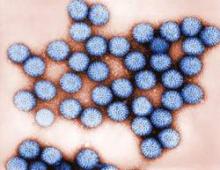Hospitalizations for acute gastroenteritis in children aged 5 years and younger plummeted after routine rotavirus vaccination was implemented in 2006, with rotavirus-specific hospitalizations plunging 94% and all-cause gastroenteritis hospitalizations dropping 55% in the most recent year for which data are available, according to a report published online June 9 in JAMA.
Researchers assessed the vaccine’s effect by analyzing information in a Healthcare Cost and Utilization Project database covering community and academic hospitals. They focused on 1,201,458 hospitalizations coded for all-cause acute gastroenteritis, including 199,812 (17%) that were coded specifically for rotavirus, which occurred in 26 states during 2000 through 2012 among children under age 5 years.
The mean annual hospitalization rate for all-cause acute gastroenteritis was 76 per 10,000 before the vaccine was introduced, which declined by 31% in 2008, 33% in 2009, 48% in 2010, 47% in 2011, and 55% in 2012. The marked decrease occurred in both boys and girls, across all race/ethnicity categories, and at all ages. The reduction was greatest among children aged 6-23 months, Dr. Eyal Leshem of the Division of Viral Diseases, Centers for Disease Control and Prevention, Atlanta, and his associates said in a research letter.
The mean annual hospitalization rate for rotavirus-specific gastroenteritis dropped even more dramatically, from 16 per 10,000 before the vaccine was introduced by 70% in 2008, 63% in 2009, 90% in 2010, 79% in 2011, and 94% in 2012, the investigators said (JAMA 2015;313:2282-4).
The nonlinear pattern of both declines “might be explained by accumulation of susceptible, nonimmune population during seasons of markedly decreased transmission,” Dr. Leshem and his associates noted.
“Our findings support continued efforts to increase rotavirus vaccine coverage,” they added.
This study was supported by the Centers for Disease Control and Prevention and the Agency for Healthcare Research and Quality. Dr. Leshem and his associates reported having no relevant financial conflicts of interest.


